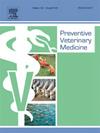Cut-off evaluation of ID Screen Mycoplasma bovis ELISA for use on bulk tank milk in New Zealand
IF 2.4
2区 农林科学
Q1 VETERINARY SCIENCES
引用次数: 0
Abstract
Repeated testing of bulk tank milk (BTM) samples and testing of serum samples has played a major role in New Zealand’s Mycoplasma bovis (M. bovis) eradication programme. We evaluated the performance of the ID Screen Mycoplasma bovis indirect ELISA on BTM samples and identified the maximal diagnostic sensitivity (DSe) and diagnostic specificity (DSp) for testing for antibodies against M. bovis in New Zealand dairy herds. Also, we investigated factors influencing DSe over the milking season and associated with the presence of antibodies against M. bovis in a sample. Data from 63 dairy herds were analysed using Bayesian latent class analysis for two conditionally dependent tests. A BTM ELISA sample-to-positive ratio (SP%) cut-off of 24 was the estimated optimal threshold yielding the optimal combination of DSe and DSp - a DSe of 78.6 % (95 % highest posterior density [HPD] interval, 50.8–93.5) and a DSp of 98.5 % (95 % HPD interval, 97.2–99.4). The presence of antibodies against M. bovis in a BTM sample was associated with herd size and the somatic cell count concentration. DSe varied markedly throughout the milking season, and was dependent on the total BTM sample volume at the time of sampling. The DSe of the ID Screen ELISA was highest for samples tested during the early and mid-stages of the milking season, and when milk vat volumes were low relative to the number of cows in milk.
ID筛选牛支原体酶联免疫吸附测定法用于新西兰散装罐奶的截止评价
在新西兰的牛支原体(M. bovis)根除规划中,反复检测散装罐奶(BTM)样本和血清样本发挥了重要作用。我们评估了ID Screen牛支原体间接ELISA对新西兰奶牛牛支原体抗体检测的性能,并确定了检测牛支原体抗体的最大诊断灵敏度(DSe)和诊断特异性(DSp)。此外,我们还调查了挤奶季节影响DSe的因素,以及与样品中牛支原体抗体存在相关的因素。采用贝叶斯潜类分析对63个奶牛群的数据进行了两个条件相关检验。BTM ELISA的样本阳性比(SP%)截止值为24,是产生DSe和DSp最佳组合的估计最佳阈值——DSe为78.6% %(最高后验密度[HPD]区间为95 %,50.8-93.5),DSp为98.5% %(最高后验密度[HPD]区间为95 %,97.2-99.4)。BTM样本中抗牛分枝杆菌抗体的存在与群体规模和体细胞计数浓度有关。DSe在整个挤奶季节变化明显,并取决于采样时BTM的总样本量。在挤奶季节的早期和中期,以及当牛奶桶体积相对于牛奶中的奶牛数量较低时,ID Screen ELISA检测的样本的DSe最高。
本文章由计算机程序翻译,如有差异,请以英文原文为准。
求助全文
约1分钟内获得全文
求助全文
来源期刊

Preventive veterinary medicine
农林科学-兽医学
CiteScore
5.60
自引率
7.70%
发文量
184
审稿时长
3 months
期刊介绍:
Preventive Veterinary Medicine is one of the leading international resources for scientific reports on animal health programs and preventive veterinary medicine. The journal follows the guidelines for standardizing and strengthening the reporting of biomedical research which are available from the CONSORT, MOOSE, PRISMA, REFLECT, STARD, and STROBE statements. The journal focuses on:
Epidemiology of health events relevant to domestic and wild animals;
Economic impacts of epidemic and endemic animal and zoonotic diseases;
Latest methods and approaches in veterinary epidemiology;
Disease and infection control or eradication measures;
The "One Health" concept and the relationships between veterinary medicine, human health, animal-production systems, and the environment;
Development of new techniques in surveillance systems and diagnosis;
Evaluation and control of diseases in animal populations.
 求助内容:
求助内容: 应助结果提醒方式:
应助结果提醒方式:


